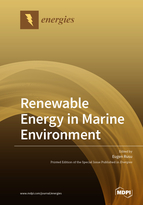Renewable Energy in Marine Environment
A special issue of Energies (ISSN 1996-1073). This special issue belongs to the section "L: Energy Sources".
Deadline for manuscript submissions: closed (15 November 2019) | Viewed by 72050
Special Issue Editor
Interests: renewable energy; marine engineering; offshore technologies
Special Issues, Collections and Topics in MDPI journals
Special Issue Information
Dear Colleagues,
We are inviting submissions to a Special Issue of Energies on the subject area of "Renewable Energy in Marine Environment" and related topics. Marine renewable sources are abundant, and the amount of energy that can be generated using existent technologies varies from site-to-site and day-to-day, depending on location and weather conditions. The technologies currently associated with energy extraction in the marine environment are highly important to achieving the expected targets in energy efficiency. On the other hand, although significant progress has been made in recent years in extracting marine energy, there are still important challenges related to the implementation of cost-effective technologies that could survive in the harsh marine environment. From this perspective, this Special Issue seeks to contribute to the renewable energy agenda through enhanced scientific and multi-disciplinary works aiming to improve knowledge and performance in harvesting renewable energy in the marine environment. We therefore invite papers on innovative technical developments, reviews, case studies, and analytics, as well as assessments, and papers from different disciplines, that are relevant to renewable energy extraction in marine environment.
Topics of interest for publication include, but are not limited to, the following:
- Conversion of the wave energy;
- Conversion of the tidal energy;
- Offshore wind;
- Floating platforms;
- Hybrid concepts;
- Modeling waves, tides, and offshore wind;
- Numerical modelling of marine energy converters;
- Physical modelling of marine energy converters;
- Arrays modelling;
- Risk and reliability assessment in marine energy extraction;
- Environmental impact of marine energy extraction;
- LCOE dynamics in marine energy.
Prof. Dr. Eugen Rusu
Guest Editor
Manuscript Submission Information
Manuscripts should be submitted online at www.mdpi.com by registering and logging in to this website. Once you are registered, click here to go to the submission form. Manuscripts can be submitted until the deadline. All submissions that pass pre-check are peer-reviewed. Accepted papers will be published continuously in the journal (as soon as accepted) and will be listed together on the special issue website. Research articles, review articles as well as short communications are invited. For planned papers, a title and short abstract (about 100 words) can be sent to the Editorial Office for announcement on this website.
Submitted manuscripts should not have been published previously, nor be under consideration for publication elsewhere (except conference proceedings papers). All manuscripts are thoroughly refereed through a single-blind peer-review process. A guide for authors and other relevant information for submission of manuscripts is available on the Instructions for Authors page. Energies is an international peer-reviewed open access semimonthly journal published by MDPI.
Please visit the Instructions for Authors page before submitting a manuscript. The Article Processing Charge (APC) for publication in this open access journal is 2600 CHF (Swiss Francs). Submitted papers should be well formatted and use good English. Authors may use MDPI's English editing service prior to publication or during author revisions.
Keywords
- renewable energy
- marine environment
- wave energy
- offshore wind
- floating platforms
- tidal energy
- osmotic energy
- resource assessment
- hybrid concepts
- numerical modeling
- laboratory modeling
- environmental impact
- economic assessments






